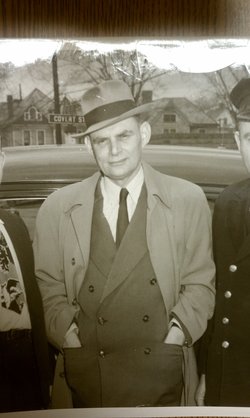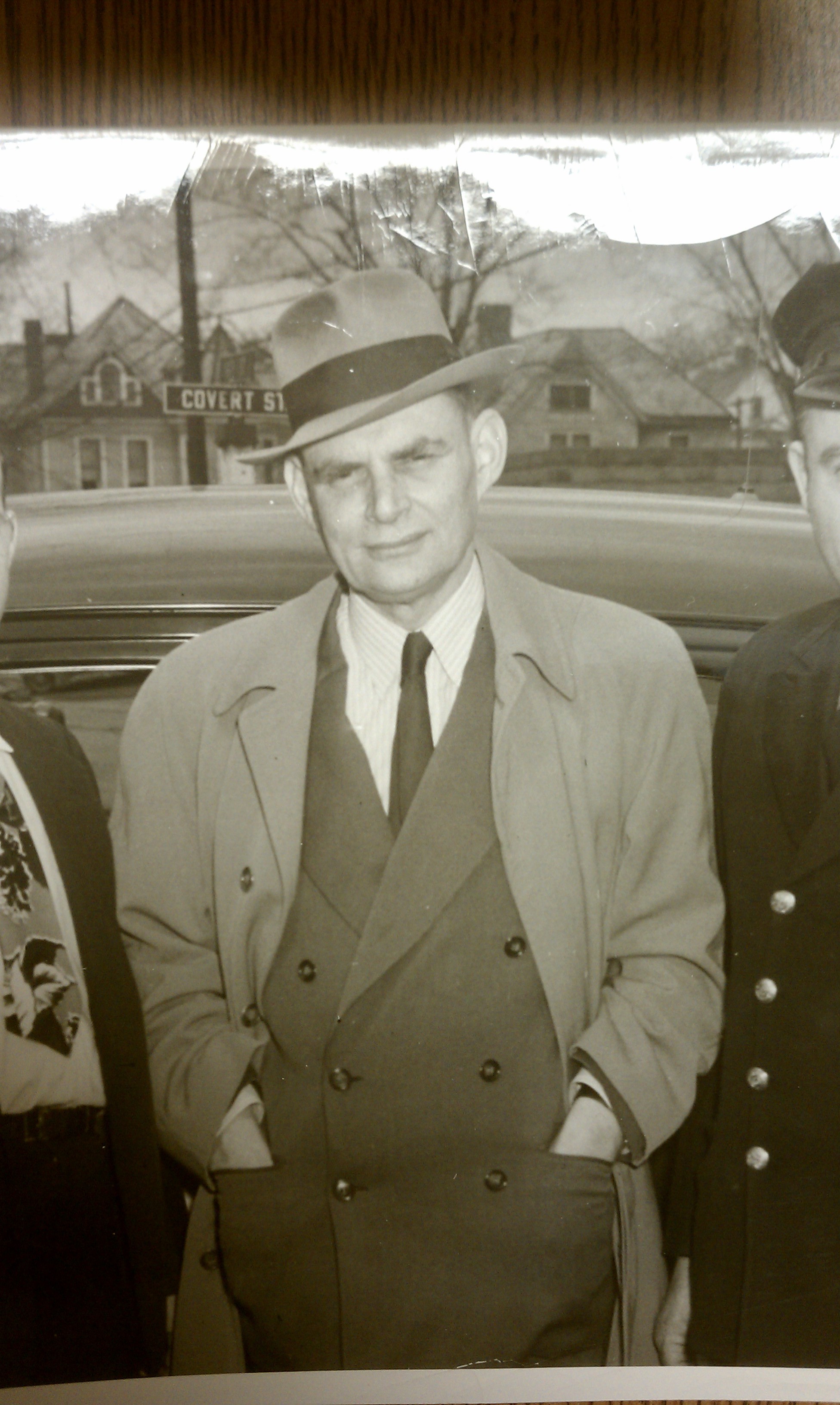Born in Fairmont, WV, he was a son of late Zadoc and Mollie Gaskill Layman. In World War I, he served with the U.S. Army as a 1st Lt., and in World War II, he was a Commander in the U.S. Coast Guard in charge of training the troops in methods of fire fighting.
Mr. Layman was Captain of the West Virginia State Police for about 10 years and he served as fire chief in Parkersburg for 20 years. He retired from the U.S. Defense Department as head of the fire fighting division.
In addition, Mr. Layman was the author of many books on firefighting and fire prevention, used nationally.
He was a member of Fairmont Baptist Temple and the Masonic Bodies.
Survining include his wife, Mrs. Sara Burnette Layman; one brother, Eugene Layman of Fairmont; and one sister, Ellen Layman of Fairmont.
Funeral services will be held at 2 p.m. Thursday at the Vaughn Funeral Home with Rev. Raymond Gimmi officiating. Chief Layman will lay at eternal rest at Mt. Olivet Cemetery, Parkersburg.
Article by J.C. Robertson, published in Fire Chief magazine, May 1, 2000
A native of West Virginia, Lloyd Layman served overseas as an officer during World War I, after which he joined the West Virginia State Police, rising to the rank of captain by 1926. He organized and directed the agency's first training academy, which became a model for other states and brought him recognition as a leader in law enforcement.
While commanding the state police unit in Parkersburg, Layman was asked to serve as the city's fire chief, a post he assumed in 1931, though not before he spent time with several progressive fire departments. Layman applied military tactics to the fire service, initiated pre-fire planning and authored "Fundamentals of Fire Fighting Tactics," which was published in 1940 and is still the basis for many of today's procedures.
After the disastrous fire on the troopship Normandie in 1942, the Coast Guard asked Layman to direct its fire research and training efforts. Commissioned and soon promoted to commander, he established and led the Coast Guard Fire Fighting School in Baltimore, which trained more than 7,200 personnel. At the time, the use of water fog was quite limited, but Layman's research through shipboard tests led to the development of the indirect application of fog as a successful suppression method.
Following World War II, Layman returned to Parkersburg as fire chief and applied the indirect attack method to structural fires, with excellent results. His talk on this method at the 1950 Fire Department Instructors Conference, "Little Drops of Water," electrified the audience. Tests in Miami and other sites confirmed its suitability, and automatic sprinkler heads were redesigned to reflect this concept. A Reader's Digest article gave international recognition to his findings, as did his work with other nations. In 1952, the nfpa published his "Attacking and Extinguishing Interior Fires" and the following year published an updated version of "Fire Fighting Tactics."
After retiring as fire chief, Layman was asked to serve as the director of the Fire Office, Federal Civil Defense Administration, the first federal position having an advocacy responsibility to the nation's fire service. He played a major role in preparing the Fire Safety and Research Act of 1968, but unfortunately died shortly before its enactment.
A strong supporter of fire prevention and arson suppression, Layman was always willing to assist any fire department, regardless of size. His dedication and abilities advanced the cause of fire protection.
Born in Fairmont, WV, he was a son of late Zadoc and Mollie Gaskill Layman. In World War I, he served with the U.S. Army as a 1st Lt., and in World War II, he was a Commander in the U.S. Coast Guard in charge of training the troops in methods of fire fighting.
Mr. Layman was Captain of the West Virginia State Police for about 10 years and he served as fire chief in Parkersburg for 20 years. He retired from the U.S. Defense Department as head of the fire fighting division.
In addition, Mr. Layman was the author of many books on firefighting and fire prevention, used nationally.
He was a member of Fairmont Baptist Temple and the Masonic Bodies.
Survining include his wife, Mrs. Sara Burnette Layman; one brother, Eugene Layman of Fairmont; and one sister, Ellen Layman of Fairmont.
Funeral services will be held at 2 p.m. Thursday at the Vaughn Funeral Home with Rev. Raymond Gimmi officiating. Chief Layman will lay at eternal rest at Mt. Olivet Cemetery, Parkersburg.
Article by J.C. Robertson, published in Fire Chief magazine, May 1, 2000
A native of West Virginia, Lloyd Layman served overseas as an officer during World War I, after which he joined the West Virginia State Police, rising to the rank of captain by 1926. He organized and directed the agency's first training academy, which became a model for other states and brought him recognition as a leader in law enforcement.
While commanding the state police unit in Parkersburg, Layman was asked to serve as the city's fire chief, a post he assumed in 1931, though not before he spent time with several progressive fire departments. Layman applied military tactics to the fire service, initiated pre-fire planning and authored "Fundamentals of Fire Fighting Tactics," which was published in 1940 and is still the basis for many of today's procedures.
After the disastrous fire on the troopship Normandie in 1942, the Coast Guard asked Layman to direct its fire research and training efforts. Commissioned and soon promoted to commander, he established and led the Coast Guard Fire Fighting School in Baltimore, which trained more than 7,200 personnel. At the time, the use of water fog was quite limited, but Layman's research through shipboard tests led to the development of the indirect application of fog as a successful suppression method.
Following World War II, Layman returned to Parkersburg as fire chief and applied the indirect attack method to structural fires, with excellent results. His talk on this method at the 1950 Fire Department Instructors Conference, "Little Drops of Water," electrified the audience. Tests in Miami and other sites confirmed its suitability, and automatic sprinkler heads were redesigned to reflect this concept. A Reader's Digest article gave international recognition to his findings, as did his work with other nations. In 1952, the nfpa published his "Attacking and Extinguishing Interior Fires" and the following year published an updated version of "Fire Fighting Tactics."
After retiring as fire chief, Layman was asked to serve as the director of the Fire Office, Federal Civil Defense Administration, the first federal position having an advocacy responsibility to the nation's fire service. He played a major role in preparing the Fire Safety and Research Act of 1968, but unfortunately died shortly before its enactment.
A strong supporter of fire prevention and arson suppression, Layman was always willing to assist any fire department, regardless of size. His dedication and abilities advanced the cause of fire protection.
Family Members
Sponsored by Ancestry
Advertisement
Advertisement








